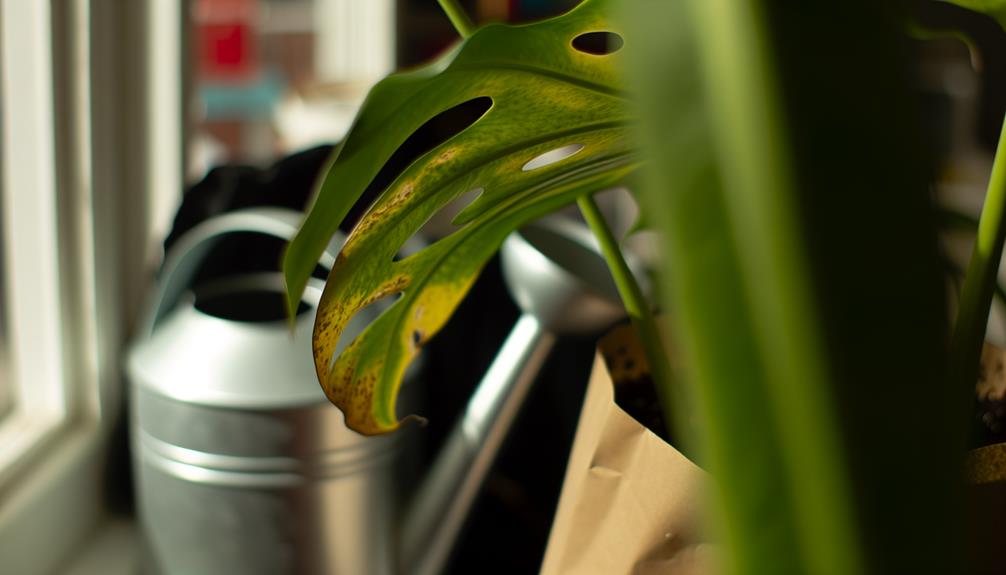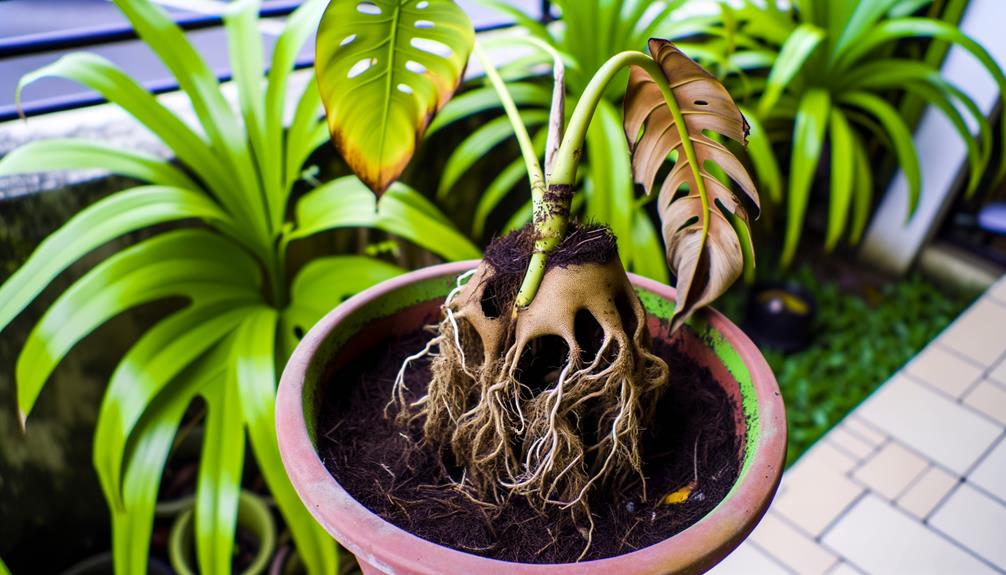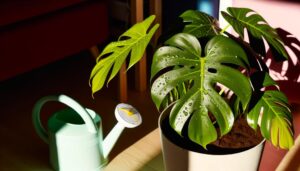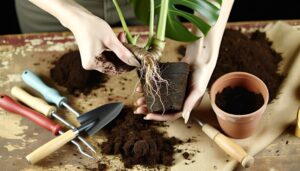Why Is My Monstera Plant Turning Yellow? Causes Revealed!
Your Monstera plant’s yellowing leaves generally indicate watering issues, light insufficiency, temperature stress, or nutrient deficiencies. Overwatering is a common cause, leading to root rot and nutrient deprivation.
Insufficient light hinders photosynthesis, while temperature fluctuations can damage cells, causing yellowing. Nutrient deficiencies, particularly in nitrogen or magnesium, also result in chlorosis.
Make sure you’re using well-draining soil, appropriate pot size, and ideal environmental conditions. Regularly check for pests like spider mites that might also be a factor.
Addressing these aspects will help you restore your Monstera’s health—continue to learn specific actions you can take for each potential issue.

Key Takeaways
- Overwatering can lead to root rot and nutrient deficiencies, causing yellow leaves.
- Insufficient light hinders photosynthesis, resulting in lower leaves turning yellow.
- Poor drainage creates waterlogged soil, leading to root decay and yellowing leaves.
- Nutrient deficiencies, especially nitrogen, magnesium, or iron, cause yellowing leaves.
- Pest infestations like spider mites or aphids can cause yellowing by damaging the plant.
Overwatering

Overwatering is one of the main reasons your Monstera plant’s leaves are turning yellow, as it leads to root rot and nutrient deficiencies. When you water too often, the soil becomes waterlogged, depriving roots of oxygen.
This anaerobic environment promotes pathogens like Pythium and Phytophthora, which cause root rot. As roots deteriorate, they can’t absorb essential nutrients, resulting in chlorosis, where leaves turn yellow due to lack of chlorophyll.
To diagnose overwatering, check the soil’s moisture level. It should be moist but not sodden. If it’s saturated, reduce watering frequency and improve drainage by adding perlite or using a well-draining potting mix.
Also, make sure the pot has drainage holes to prevent water accumulation, which worsens the problem.
Underwatering
If your Monstera’s leaves are turning yellow and the soil feels dry, underwatering is likely the issue. Adjusting your watering frequency can mitigate the problem, ensuring the plant receives adequate hydration.
Regularly monitor soil moisture levels using a soil moisture meter to maintain ideal conditions.
Dry Soil Symptoms
Dry soil symptoms, such as curling leaves and crispy leaf edges, often indicate that your Monstera plant isn’t receiving sufficient water. When the soil becomes too dry, it fails to provide the necessary hydration for cellular processes, leading to structural damage in the leaves. You might notice yellowing as the chlorophyll degrades, which is a defensive response to conserve resources.
To confirm inadequate watering, check the soil moisture level by inserting your finger about two inches deep. If it feels dry, this supports the dehydration hypothesis. Additionally, you can use a moisture meter for more precise readings.
Watering Frequency Adjustment
To effectively address underwatering, increase the watering frequency to make certain the soil remains consistently moist but not waterlogged. Gradually adjust your watering schedule, aiming for even moisture distribution.
Check that water penetrates the root zone, as insufficient hydration can worsen yellowing. Utilize room-temperature water to prevent shock to the plant. Evidence shows that Monstera species thrive in slightly damp conditions, resembling their native tropical environments.
Pay close attention to the pot’s drainage holes to prevent water accumulation, which may cause root rot. If the top inch of soil feels dry, it indicates the need for watering. Document your watering intervals to track changes and ensure uniformity.
Soil Moisture Monitoring
Accurately monitoring soil moisture is paramount to preventing underwatering and ensuring your Monstera plant receives the hydration it needs. Utilize a soil moisture meter for precise readings. In its absence, insert your finger into the soil up to the second knuckle to gauge moisture levels.
Employ the following steps:
- Measure consistently: Check soil moisture at the same time daily.
- Document readings: Keep a log of moisture levels to identify patterns.
- Adjust watering accordingly: Modify your watering schedule based on the data collected.
These steps provide an evidence-based approach to soil moisture monitoring. Over time, you’ll discern your Monstera’s specific requirements, mitigating the risk of yellowing leaves due to underwatering. Consistency and documentation are essential to mastering this technique.
Poor Drainage

When your Monstera’s soil retains an excess amount of water, it can lead to poor flow, which is a primary cause of yellowing leaves. Poor flow results in waterlogged soil, depriving roots of necessary oxygen. This leads to root decay, characterized by a foul smell and blackened roots.
To ensure proper flow, use a well-draining potting mix containing perlite or orchid bark. Confirm your pot has drainage holes; stagnant water is harmful. Elevate pots with saucers to prevent water accumulation. Regularly inspect the drainage system; clogs can hinder water movement.
Overwatering exacerbates poor flow, so water only when the top inch of soil is dry. Understanding and addressing flow issues is essential for your Monstera’s health and foliage strength.
Insufficient Light
Insufficient light can hinder your Monstera’s photosynthesis process, causing leaves to turn yellow due to a lack of chlorophyll production. When your plant doesn’t receive adequate light, it can’t produce the energy it needs for healthy growth.
To diagnose this issue, consider the following:
- Location: Assess if your Monstera is placed in a dimly lit room or far from windows.
- Growth Patterns: Observe if the plant’s growth is stunted or if it’s leaning towards the light source.
- Leaf Coloration: Note if the yellowing starts from the lower leaves, indicating insufficient light reaching those areas.
Excessive Light

Excessive light exposure can cause your Monstera’s leaves to turn yellow due to direct sunlight damage.
Extended periods of intense light can disrupt chlorophyll production and lead to photobleaching.
To mitigate this, you should monitor light duration and adjust the plant’s placement to achieve ideal light levels.
Direct Sunlight Damage
Direct sunlight can lead to the leaves of your Monstera plant turning yellow by causing photodamage and disrupting chlorophyll production. When exposed to excessive light, your Monstera experiences oxidative stress, leading to cellular damage. This results in impaired photosynthesis and nutrient deficiency.
Key indicators of direct sunlight damage include:
- Yellow Leaf Margins: The edges of the leaves may turn yellow and become crispy.
- Brown Patches: Look for brown, sunburn-like spots on the leaves.
- Leaf Curling: Leaves may curl to reduce the surface area exposed to intense light.
Photodamage not only affects the leaf color but also the plant’s overall health. Ensure your Monstera receives bright, indirect light to prevent these issues and promote peak growth.
Light Duration Effects
Prolonged exposure to high light intensity can cause your Monstera plant’s leaves to turn yellow due to the overstimulation of photosynthetic processes. When light duration exceeds the best range, chlorophyll production accelerates excessively, leading to a breakdown of pigmentation in the leaves.
This phenomenon, known as photobleaching, occurs because the chloroplasts are overworked and can’t sustain efficient photosynthesis. Studies indicate that Monstera plants require moderate light levels, around 200-500 foot-candles, for ideal growth. Excessive light not only disrupts their physiological balance but also depletes essential nutrients faster.
Consequently, you might observe yellowing leaves as an early symptom of light stress. Monitoring the light duration and intensity is essential to maintaining your Monstera’s health and preventing further damage.
Adjusting Light Levels
To lessen the impact of high light intensity on your Monstera plant, start by relocating it to a spot with filtered or indirect light, making sure it receives about 200-500 foot-candles for best health. Excessive light can cause chlorophyll degradation, leading to yellowing leaves.
Follow these steps:
- Use sheer curtains to filter direct sunlight, creating an ideal environment.
- Monitor light levels with a light meter to make certain the plant isn’t exposed to too much brightness.
- Rotate the plant periodically to distribute light evenly and prevent leaf burn.
Scientific evidence underscores the importance of proper light levels in plant health. Adjusting light conditions can greatly enhance your Monstera’s well-being, reducing stress and promoting lush, green foliage.
Temperature Stress
Temperature fluctuations can greatly impact the health of your Monstera, often leading to yellowing leaves. Monstera plants thrive within a temperature range of 65-85°F (18-29°C).
When exposed to temperatures below 55°F (13°C) or above 95°F (35°C), your plant can experience cellular damage, impairing chlorophyll production and causing yellowing.
Extreme temperature changes, such as drafts or proximity to heating vents, disrupt the plant’s metabolic processes. Consistent temperature is essential; sudden drops or spikes stress the plant, leading to symptoms like yellow leaves.
Maintain stable indoor temperatures and avoid placing your Monstera near windows or doors that frequently open and close. Monitoring and regulating ambient temperature guarantees your Monstera remains vibrant and healthy.
Humidity Levels

Humidity levels play a crucial role in the health of your Monstera, as insufficient humidity can lead to yellowing leaves by causing the plant to lose moisture too rapidly. Best humidity levels for Monstera plants range between 60-80%.
If your indoor environment is too dry, you can take several steps to increase humidity:
- Use a Humidifier: Place a humidifier near your Monstera to maintain consistent moisture levels.
- Mist the Leaves: Regularly mist the leaves with water to provide temporary humidity.
- Group Plants Together: Positioning multiple plants close to each other creates a microenvironment with higher humidity.
Consistent monitoring with a hygrometer will help you maintain the ideal conditions for your Monstera, ensuring it stays vibrant and healthy.
Nutrient Deficiency
Nutrient deficiencies often manifest in Monsteras through yellowing leaves, indicating that the plant isn’t receiving essential minerals like nitrogen, magnesium, or iron. Nitrogen deficiency typically results in older leaves turning yellow first, as the plant reallocates this important nutrient to new growth.
Magnesium deficiency can cause interveinal chlorosis, where the area between leaf veins turns yellow while veins remain green. Iron deficiency, often linked to high soil pH, leads to young leaves yellowing with green veins.
Examine your Monstera’s fertilization schedule and soil composition. Utilize a balanced, water-soluble fertilizer to address these deficiencies, ensuring an even distribution of macro and micronutrients. Regularly monitor soil pH and nutrient levels to maintain top plant health and prevent recurrence.
Root Bound

If your Monstera’s leaves are turning yellow, it might be due to root-bound conditions, restricting proper root growth.
You’ll notice signs like roots growing out of the drainage holes or the plant becoming pot-bound.
To address this, repotting into a larger container with fresh soil is essential to restore healthy growth.
Restricted Root Growth
Have you noticed your Monstera’s leaves turning yellow despite proper watering and sunlight? This could indicate restricted root growth due to the plant being root bound. When a Monstera’s roots outgrow their container, they struggle to absorb essential nutrients and water.
Here’s how restricted root growth affects your plant:
- Nutrient Deficiency: Limited soil space decreases nutrient availability, leading to yellowing leaves.
- Water Stress: Confined roots can’t store or distribute water effectively, causing dehydration or waterlogging.
- Growth Stagnation: Overcrowded roots hinder new growth, making the plant weak and susceptible to diseases.
Examining your Monstera’s root system can provide insights into its health and help you determine if it’s time to address the root-bound issue.
Repotting Signs
You’ll need to identify specific signs that indicate it’s time to repot your Monstera, ensuring the plant recovers from restricted root growth and continues to thrive.
Look for roots emerging from drainage holes, which signal that the root system has outgrown its current container.
Additionally, if the plant’s growth rate slows despite adequate light and water, it may be root bound.
Yellowing leaves can also be a symptom of nutrient deficiency caused by overcrowded roots.
Carefully inspect the soil; if you notice roots circling the pot’s interior, repotting is necessary.
Choose a container 2-4 inches larger in diameter and use fresh, well-draining soil. This will provide the roots with the space and nutrients they need to flourish.
Pest Infestation
Pest infestations frequently cause Monstera plant leaves to turn yellow as insects such as spider mites, aphids, or scale insects sap essential nutrients. These pests extract plant fluids, leading to nutrient deficiency and yellowing leaves.
To identify pest presence:
- Inspect the Underside of Leaves: Check for small, moving dots or webbing, indicative of spider mites.
- Look for Sticky Residue: Aphids and scale insects secrete a sticky substance called honeydew, which can attract mold.
- Examine Leaf Discoloration Patterns: Uneven yellowing often points to localized pest feeding.
Regularly monitor your Monstera for these signs. Using a magnifying glass can help you spot these tiny invaders.
Early detection and treatment with insecticidal soap or neem oil can mitigate damage and restore plant health.
Fungal Infection

In addition to pest infestations, fungal infections can also cause Monstera plant leaves to turn yellow, often manifesting as spots or patches that gradually expand. Fungal pathogens like Fusarium, Pythium, and Phytophthora thrive in overly moist conditions, attacking the plant’s vascular system and impairing nutrient transport.
You’ll notice yellowing accompanied by wilting or browning edges. To diagnose, inspect the soil for excess moisture and poor drainage. Implement a treatment strategy by improving air circulation, reducing watering frequency, and applying a fungicide specifically labeled for houseplants. Prune affected leaves with sterilized tools to prevent further spread.
Monitoring environmental conditions and maintaining the best humidity levels will help prevent future fungal infections in your Monstera plant.
Chemical Sensitivity
Exposure to chemicals, such as fertilizers, pesticides, or cleaning products, can lead to chemical sensitivity in Monstera plants, resulting in yellowing leaves and other signs of stress. When your Monstera encounters harmful chemicals, its cellular processes can become disrupted, leading to chlorosis and necrosis.
To prevent chemical sensitivity, consider these precautions:
- Dilute Fertilizers: Use only half the recommended strength to avoid root burn.
- Natural Pesticides: Opt for organic or homemade solutions that are less harmful.
- Isolate Cleaning Products: Make sure that cleaning agents don’t come into contact with your plant.
Implementing these measures can greatly reduce the risk of chemical stress, ensuring your Monstera remains vibrant and healthy.
Always monitor for signs of distress after chemical exposure.
Conclusion
To sum up, your Monstera’s yellowing leaves could stem from several factors, such as overwatering, underwatering, poor drainage, and light issues. It’s like exploring a jungle of potential problems! Examining these aspects meticulously will help you pinpoint the issue.
Keep an eye out for root binding, pest infestations, fungal infections, and chemical sensitivities. By addressing these concerns, you’ll transform your plant from drab to fab, restoring its lush, green glory in no time.






